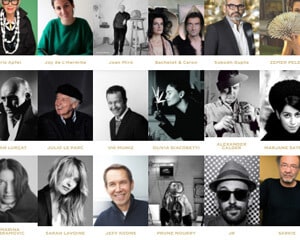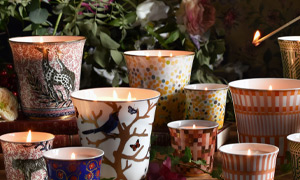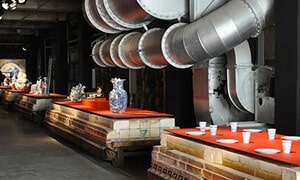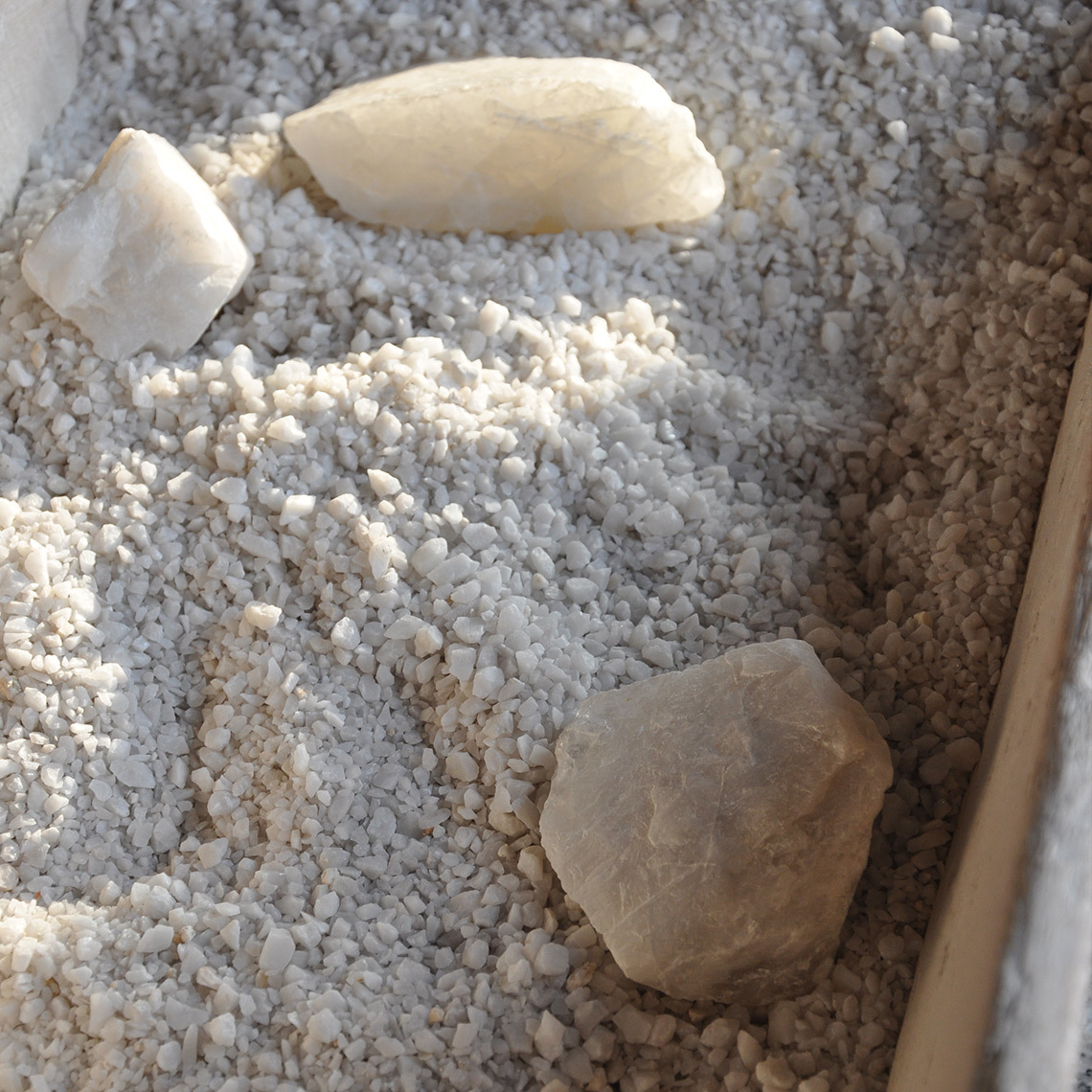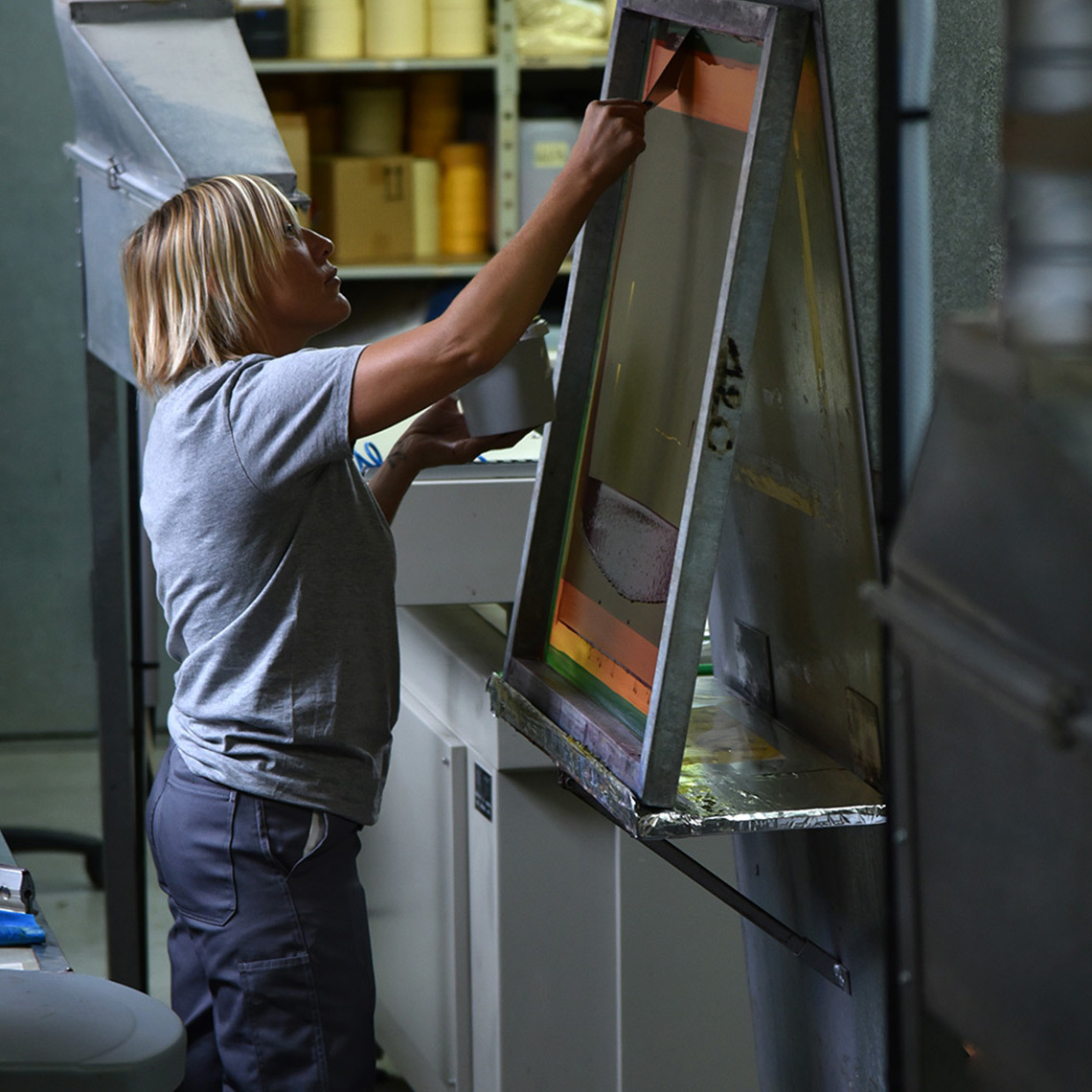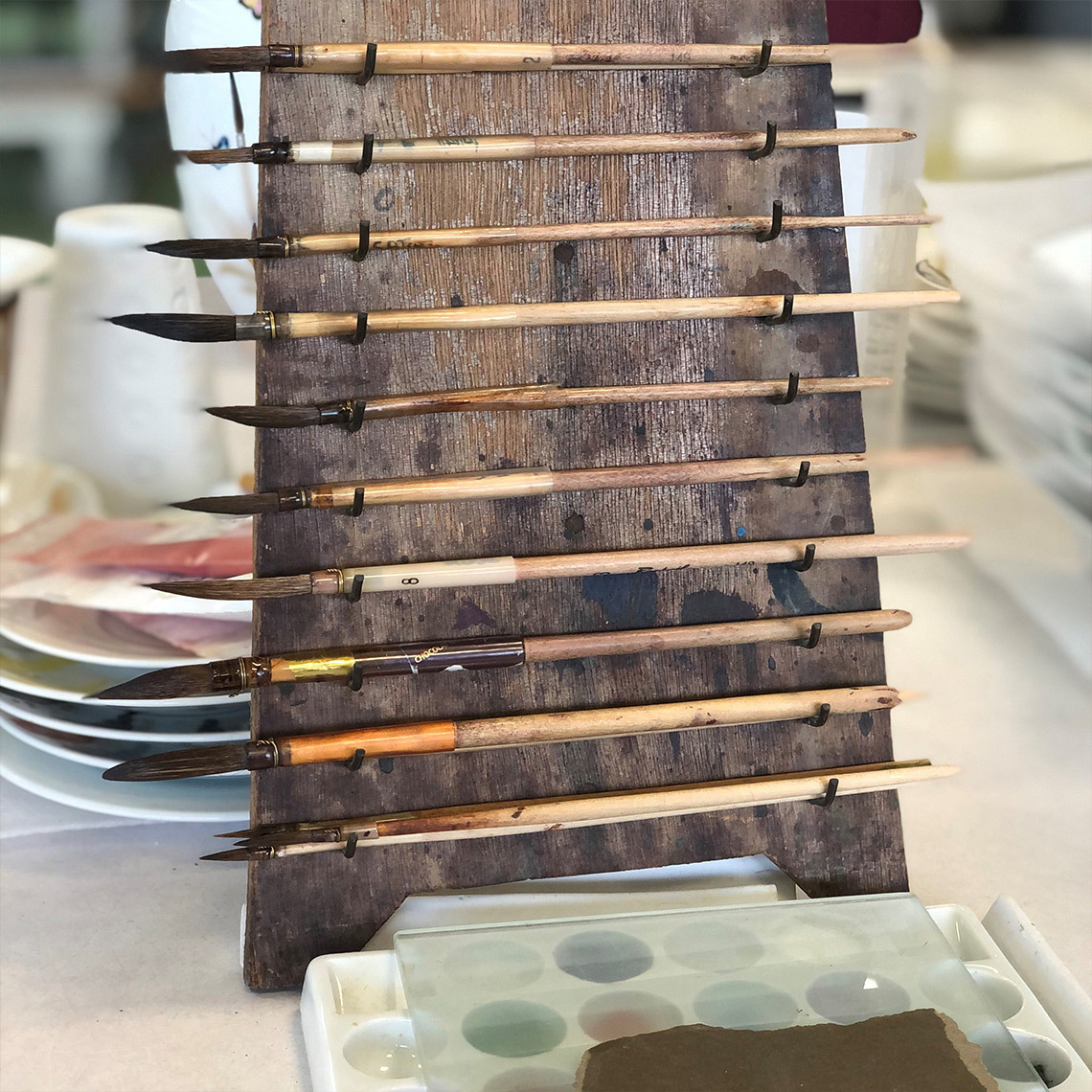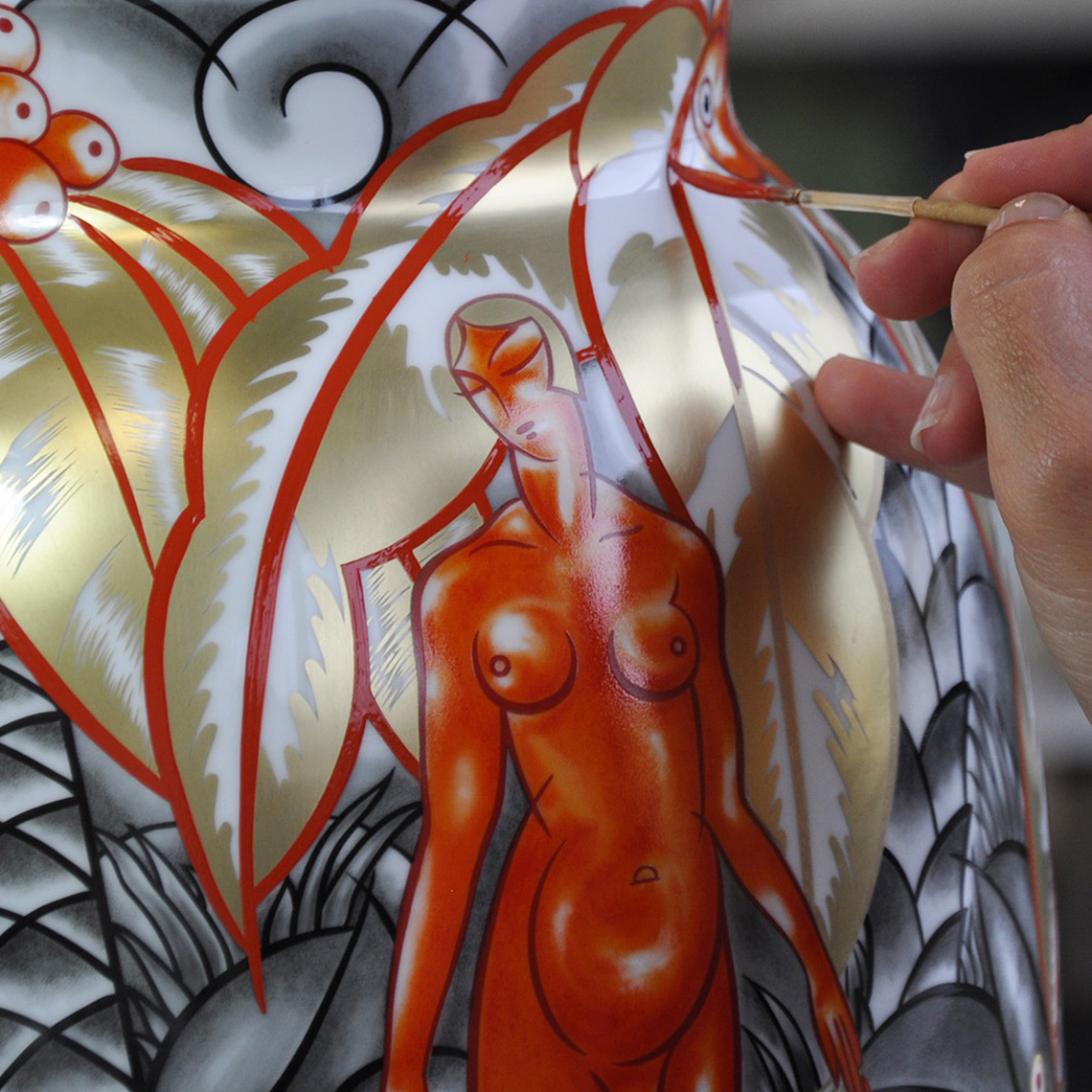Bernardaud manufactures porcelain at two factories, one in downtown Limoges and the other in its region. Their combined output is about two million pieces a year.
THREE KEY MINERALS
The recipe for porcelain paste is 50% kaolin, 25% quartz and 25% feldspar. These substances are diluted in water, then ground, mixed, sifted and filtered. They are presented in slab form before being converted into pastes of varying liquidity, depending on the manufacturing technique.
PASTES
- Slip: liquid paste used for casting
- Semi-hard paste: deaerated and kneaded into the shape of a cylinder of semi-hard paste, used for calibrating
- Powder: spray-dried to get a granular powder that is directly compressed by isostatic pressing
MOLDS
The first step in the fabrication of a porcelain piece is the creation of a model. From an image of the finished object to its final scale, the modeler must create the object in plaster in “raw size” scale that is 14% larger than the actual size of the finished piece. This is to anticipate shrinkage during firing.
The model, which is the only reference object, serves to make the master mold. The latter, also known as the core, is used to create mass production molds made of plaster, resin or polyurethane-coated steel.
CASTING is a process used for hollow pieces (e.g. coffee pots, vases and soup tureens). Slip is poured into plaster moulds. Plaster being porous, it absorbs the water contained in the paste and sets in the mould. After a specified setting time, proportional to the size of the piece (e.g. about thirty minutes for a soup tureen), the excess slip is removed and the pieces are taken out...
CALIBRATING is a process used in the manufacture of round and raised pieces (e.g. cups and salad bowls). A slab of semi-hard paste is introduced into a mold, which is then placed on a potter’s wheel. A metal template comes down and flattens the paste, spreading it against the sides of the mold and cutting away any excess paste. There are two types of calibration : ‘‘jollying’’ yields the interior profile of the piece, and ‘‘jiggering’’ the external profile.
ISOSTATIC PRESSING
The isostatic pressing process has been used since the 1980s to manufacture pieces that are round and flat, such as plates. The granular paste (the powder obtained by spraying slip) is compressed at a pressure of about 350 bars inside a steel and polyurethane mould. The porcelain powder compacted forms the object. The need for drying time is eliminated.
DRYING
After the pieces are taken out, the drying process begins. The time will vary between 12 to 24 hours depending on the size of the objects. During the drying process, the pieces shrink by 3%.
HANDLE STICKING calls for adding fittings (e.g. spouts or handles) using slip strengthened with a binder. This is when holes are made in the spouts of tea and coffee pots.
FETTLING means removing the seams that occur where two or more molds meet, as well as any other imperfections.
THE FIRST FIRING
Pieces undergo a first firing at 980°C during 24 hours in kilns, which are currently gas-fired. This operation hardens and dehydrates each piece, making it porous so that the glaze fixes itself to the surface.
GLAZING
After the first firing, the pieces are brittle and porous. Their porosity enables the process of glazing. Each piece is hand-dipped into a glaze slop to obtain a smooth, shiny appearance. Unglazed objects look matte and are known as ‘‘bisque’’. Glaze is made of the same ingredients as porcelain paste, but the proportions are different. Glazing is a very elaborate technique, executed by hand. It must ensure an even thickness on the surface of each piece. The work of a glazer must be very precise, but can be done quickly : an experienced artisan can glaze 1,200 saucers per hour.
THE SECOND FIRING
Pieces then undergo a second, “grand feu” firing at 2,552°F for 24 hours in gas-fired kilns. The purpose is to vitrify the paste and glaze to augment the whiteness, translucency, resonance and hardness of the porcelain. During this operation, the piece undergoes significant shrinkage (10 to 12% compared to the model) and reaches its final size..
PICKING
This is the final step in the manufacture of white products. Each piece is individually checked and graded for quality. Even though many quality checks have already been carried out, over 25% of all pieces produced are rejected. The most common defects are stains, cracks, patches of missed glaze, deformations or splits. Some flaws can be repaired.
DECORATION
The complexity of the decoration depends on the style of a collection. Certain valuable pieces are hand-painted by craftsmen with great dexterity using a wide variety of paint brushes. In most cases, decals or leaf decorations, which use the same technique as transfers, are affixed by hand to the white porcelain.They are dipped in water to detach the motif from its paper support and placed on the piece. These decals are made using different printing processes (originally lithography, currently serigraphy). Bernardaud is one of the very few factories to have its own printing plant. Lines and fittings (e.g. handles and spouts) are all hand-painted. These are the most common decorative techniques. Special techniques, such as incrustation or gold relief, are sometimes used for bespoke work.
INCRUSTATION is a porcelain decoration process that uses acid engraving. A decal printed with a protective varnish, rather than color, is applied to a piece. This varnish, which is an acid-resistant material, is applied by brush to the rest of the piece, except for the motif, which will be engraved. Next, it is dipped into a bath of hydrofluoric acid that “attacks” the glaze, engraving the cavities called for by the design. The piece is rinsed in petrol, detergent and water, then decorated with two consecutive layers of gold (brilliant followed by matte) or bright platinum, which requires two firings.Gold relief is a decorative technique whereby an embossed gold motif is applied by brush using a special paste. After firing, the decoration is dusted with fine gold and then given another firing.
GOLD POLISHING
The final operation for pieces featuring goldwork is gold polishing. After it has been fired, the gold looks matte. Once polished, rubbed with a cloth and sand, the piece takes on a shiny appearance.
QUALITY CONTROL
Before shipment to a final destination, every piece is given a careful final check to make sure that the Bernardaud products sold around the world are of the highest quality.












